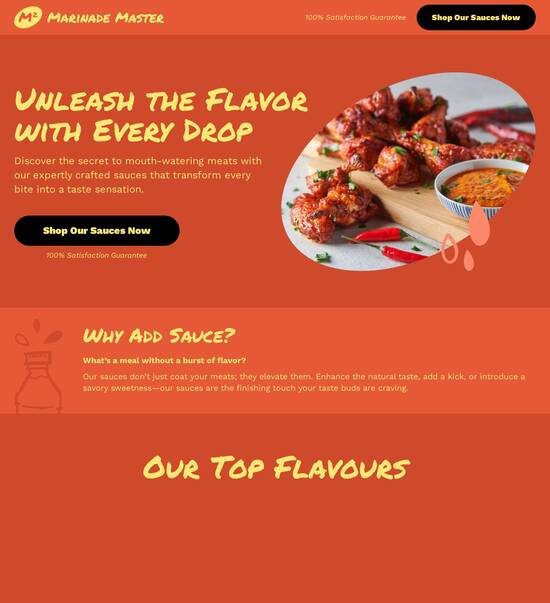
HTML page template with interactive ad banner
Explore Similar TemplatesAbout template
Use HTML page templates with interactive ad banner and make your communications easy and transparent. Try our solution today.
Recommended templates

Easy to build without coding
With the intuitive drag-and-drop builder, anyone on your team can create high-converting pages without any knowledge of code or design. Make enhancements to your landing page with custom widgets using Javascript, HTML/CSS, or third-party scripts.

Multiple layouts for any industry and goal
Select from 500+ landing page layouts built to boost conversions across industry-specific scenarios. Customize them by adjusting fonts, adding images, and generating on-brand content with the AI assistant. Quickly scale with Instablocks® and Global Blocks that you can save, reuse, and update globally.

Loads fast and looks polished on any device
Every template is responsive, which means they present professionally on any device and load blazingly fast with our Thor Render Engine. You can also power them up with Google AMP technology to deliver an unparalleled mobile experience and drive higher conversions.

Robust analytics & experimentation
Get real-time updates and reporting across all your devices, showing the number of visitors, conversions, cost-per-visitor, and cost-per-lead. Launch AI-powered experiments, run A/B tests, and use heatmaps to analyze user behavior, then optimize your landing page to maximize conversions.







Easy to build without coding
With the intuitive drag-and-drop builder, anyone on your team can create high-converting pages without any knowledge of code or design. Make enhancements to your landing page with custom widgets using Javascript, HTML/CSS, or third-party scripts.
Multiple layouts for any industry and goal
Select from 500+ landing page layouts built to boost conversions across industry-specific scenarios. Customize them by adjusting fonts, adding images, and generating on-brand content with the AI assistant. Quickly scale with Instablocks® and Global Blocks that you can save, reuse, and update globally.
Loads fast and looks polished on any device
Every template is responsive, which means they present professionally on any device and load blazingly fast with our Thor Render Engine.
Robust analytics & experimentation
Get real-time updates and reporting across all your devices, showing the number of visitors, conversions, cost-per-visitor, and cost-per-lead. Launch AI-powered experiments, run A/B tests, and use heatmaps to analyze user behavior, then optimize your landing page to maximize conversions.
All the features you need to build html5 ad templates addons
Explore more featuresLearn how to build html5 ad templates apps
Frequently asked questions about banner ad templates
Leading the way in building high-performing landing pages





Html banner maker: Your ultimate how-to guide
Creating an engaging landing page is crucial for any digital marketing campaign. With Instapage, marketers can easily set up high-converting landing pages that maximize ROI using intuitive design tools and pre-built templates tailored for various sectors, including education and financial services.
Understanding the power of Instapage templates
Instapage offers over 100 customizable templates designed to capture leads effectively. Marketers can leverage these ready-made options to avoid tedious design tasks and instead focus on crafting compelling content that resonates with their audience. Utilizing templates speeds up the page-building process and offers a head start in forming a digital strategy.
- High-conversion design: Templates are crafted based on proven tactics to ensure conversion rates remain high.
- Ease of use: With a drag-and-drop interface, even those without technical expertise can personalize templates.
- Mobile responsiveness: Templates are optimized for mobile to provide a seamless user experience across devices.
Optimizing landing pages for success
Instapage integrates robust optimization tools that allow users to enhance their landing page performance continually. Marketers can A/B test different elements, track user interactions via heatmaps, and evaluate the overall effectiveness of their pages.
- A/B testing: Experiment with headlines, images, and calls-to-action (CTAs) to determine which variations yield the best results.
- Heatmaps: Visualize user behavior to identify areas of interest and improvement opportunities.
- Analytics Dashboard: Comprehensive performance metrics help guide strategic decisions.
Personalizing content to increase engagement
With Instapage, users can create dynamic experiences tailored to specific audience segments. Personalization features allow marketers to deliver content that speaks directly to the needs and interests of visitors.
- Dynamic text replacement: Automatically change text based on user characteristics to enhance relevance.
- AdMaps: Align specific ads with tailored landing pages for better conversion efficiencies.
- Audience-level tracking: Monitor user engagement metrics for enhanced insights into audience behavior.
Ultimately, the right tools coupled with well-optimized landing pages can significantly improve your marketing outcomes. Instapage enables businesses to create, test, and personalize landing pages with ease.
Discover how you can leverage Instapage to transform your digital marketing campaigns today! Whether you're a small business or part of a larger organization, this platform has the resources to enhance your marketing efforts.
Sign up for Instapage now to access our vast array of tools and templates designed for marketers like you!
People also ask about html banner ads
Unveiling the power of HTML page templates with interactive ad banners
The evolution of advertising in the digital landscape
Advertising has seen a remarkable transformation over the years, moving from static to interactive formats. The shift began with the need to capture user attention in an increasingly crowded online environment. Traditional ads, often static and lacking interactivity, have gradually given way to dynamic HTML5 banners, which engage users more effectively. This evolution reflects a broader trend in marketing that acknowledges the necessity of user engagement and its profound impact on advertising success.
As technology advanced, interactive elements began to emerge prominently in digital marketing strategies. Marketers recognized that users respond more positively to experiences that involve interaction. Features such as clickable buttons, animations, and multimedia elements encourage users to explore content, making their visit more enjoyable. Consequently, businesses that leverage interactive components in their ads often see higher conversion rates and overall success.
Understanding HTML5: The backbone of modern advertising
HTML5 has emerged as the preferred framework for developing interactive ad banners, largely due to its robust features. Unlike earlier technologies, HTML5 allows for seamless integration of multimedia elements such as audio and video, enhancing the overall user experience. The ability to create visually striking displays with animations and transitions has made HTML5 a game-changer in the advertising landscape.
One of the standout features of HTML5 is its responsiveness across various devices. Ads designed with HTML5 automatically adapt to the screens of desktops, tablets, and smartphones. This adaptability ensures that users receive a consistent experience regardless of their device, contributing to increased engagement rates. With built-in multimedia capabilities, HTML5 effectively meets the diverse demands of modern advertising.
Designing an effective interactive ad banner
Creating successful interactive ad banners requires careful consideration of various elements. Clear visuals and concise text are crucial; cluttering a banner with too much information can detract from its effectiveness. A straightforward approach with a strong visual appeal and a few well-chosen words typically achieves the best results. Additionally, incorporating a strategic call-to-action (CTA) is vital, as it encourages users to take the desired action after viewing the banner.
Choosing the right format is also essential for an advertising campaign's success. Interactive ad banners can be presented in various sizes and placements, each with its unique advantages. Marketers should consider standard formats, such as leaderboard or skyscraper banners, and also explore interactive formats that allow for more engagement. Prioritizing visibility and ensuring that ads align with campaign objectives can significantly impact overall performance.
Engaging your audience: Strategies for captivating banners
To create ads that truly engage users, it's critical to understand your target audience thoroughly. Audience segmentation plays a vital role in tailoring content that meets unique preferences and needs. By analyzing demographic data and user behavior, marketers can craft banners that resonate with specific groups, thereby enhancing engagement rates. Recognizing different segments allows for the development of personalized experiences that drive action.
Incorporating storytelling techniques is another effective strategy in banner designs. Sharing a narrative can evoke emotions and create a connection with viewers. Additionally, utilizing personalization methods, such as customized messages based on users' prior interactions, can significantly boost engagement. Creating advertisements that reflect the audience's values and interests promotes deeper connections and encourages positive responses.
The role of multimedia in interactive banners
Multimedia elements, particularly videos, are potent tools for maximizing an ad's impact. Video banners can deliver information quickly and engagingly, allowing viewers to consume content effectively. It’s crucial to follow best practices when integrating videos; these practices include ensuring quick loading times, providing subtitles, and maintaining a clear message that aligns with brand objectives. When executed well, video content has proven to enhance user engagement significantly.
In addition to videos, animations and graphics bring banners to life and help draw viewers' attention. Utilizing motion graphics can provoke curiosity and encourage interaction. Marketers can employ various tools and platforms for crafting animated HTML5 banners that stand out in competitive environments. These creative assets not only enhance visual appeal but also create memorable brand experiences that lead to effective campaigns.
Measuring the impact of interactive ad campaigns
Evaluating the performance of interactive ad banners is essential for determining their effectiveness. Key metrics to track include click-through rate (CTR), conversion rates, and engagement levels. By understanding these data points, marketers can refine their strategies to improve overall outcomes. Implementing A/B testing is a practical approach that allows for testing different design elements or messaging to identify what resonates most with audiences.
Establishing a feedback loop with customers also contributes to improved ad performance. Gathering insights through surveys and data analytics enables marketers to adapt their strategies based on real audience feedback. Continuous improvement is vital in a fast-moving digital landscape, and utilizing audience input can drive innovative approaches while responding to evolving market demands.
The role of reputation in ad effectiveness
User trust plays an intricate role in the effectiveness of advertising campaigns. Building trust involves delivering quality advertising that resonates with audiences. Users are more likely to engage with brands they perceive as authentic and transparent. Incorporating interactive elements into ads can enhance this perception by creating an experience that feels more personal and credible.
Monitoring how audiences perceive advertisements is crucial for maintaining brand reputation. Strategies for managing online reputation include being responsive to audience inquiries and proactively addressing any negative feedback. By prioritizing transparency in advertising efforts, brands can foster stronger relationships with their consumers, bolstering both trust and engagement over time.
Examples of successful interactive ad banners
Successful campaigns utilizing HTML5 interactive banners have emerged as benchmarks in the industry. A notable case study includes a tech company that integrated user participation with a gamified ad format, resulting in significant increases in engagement and conversions. This campaign effectively showcased the brand's products while creating a fun and interactive experience for users. Analysis of these effective campaigns typically reveals strategies based on understanding the audience and selecting the right interactive elements.
Various industries have adopted innovative uses of interactive banners. In the retail sector, companies have employed shoppable ads that allow users to click through and make purchases directly from the banner. The tech sector has leveraged interactive demos in product ads, showcasing features in an engaging manner. These innovative applications inspire creativity and serve as valuable templates for marketers looking to enhance their own interactive advertising strategies.
Future trends in interactive advertising
The future of interactive advertising appears promising, particularly with the growing role of augmented reality (AR) and virtual reality (VR). These technologies are set to transform standard banners into immersive experiences that engage users like never before. With the capability to create interactive 3D environments, brands can provide unique experiences that encourage exploration and interest. Anticipated developments in technology will further enrich these immersive experiences, opening new doors for creativity in advertising.
In addition, sustainability has become a significant focus in digital marketing. The shift towards eco-friendly advertising practices reflects a growing awareness of environmental impacts. Brands that prioritize responsible advertising methods will likely resonate with environmentally conscious consumers. By adopting these practices, marketers can contribute not only to their brand image but also to a more sustainable advertising ecosystem.
Best practices for implementing interactive ad banners
Implementing effective interactive ad banners requires attention to detail and strategic planning. A successful banner campaign should include several essential elements, such as clear visuals, a compelling message, and an effective call-to-action. In addition, consistent branding should be maintained across all advertisements to enhance recognizability. Marketers should also prioritize performance optimization for different platforms to ensure that banners are equally effective whether viewed on a desktop, tablet, or mobile device.
There are common pitfalls to avoid when creating interactive ads. One major misstep is overwhelming users with excessive information or overly complicated interactions. It’s crucial to keep banners straightforward and impactful. Continuous assessment and iteration based on analytics and user feedback can foster ongoing improvement and innovation in ad design, allowing marketers to stay ahead in a fast-paced digital marketing environment.
Ready to skyrocket conversions?
Supercharge your ad campaigns with high-performing landing pages
Get started














